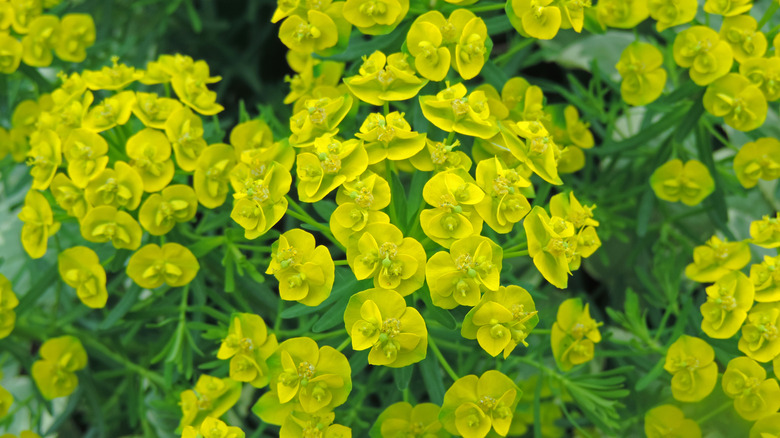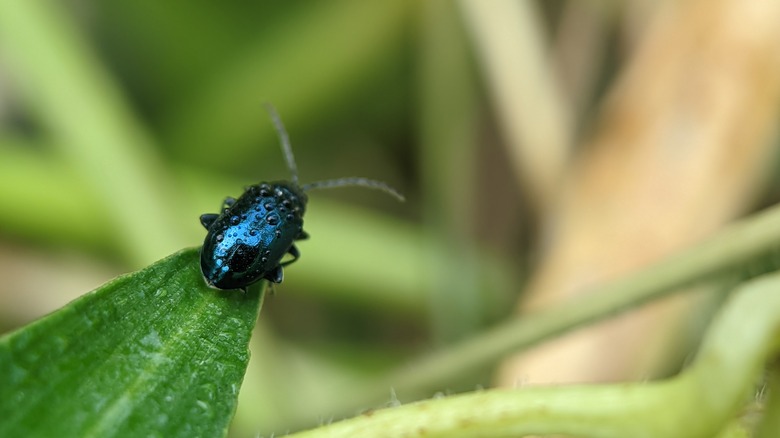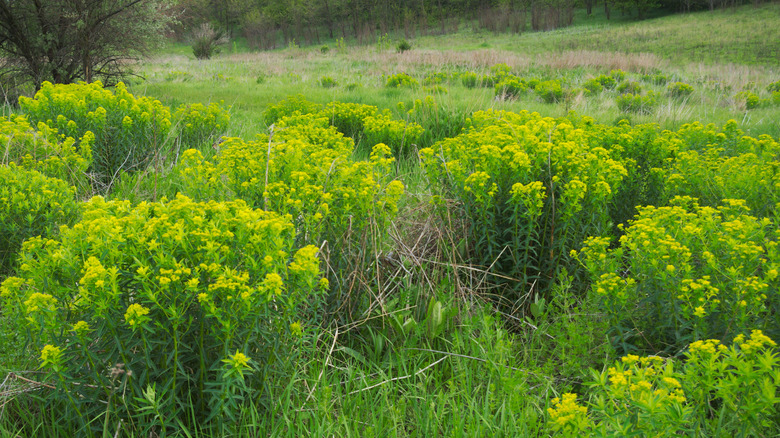Eliminate Spurge Weeds With An Unexpected Insect
Although native to Eurasia, leafy spurge weed is a perennial weed that's commonly found in North America. Because it grows so well, it can do a lot of damage around the home and on large, remote acreage. Leafy spurge grows close to concrete roadsides and driveways, and on pastures and lawns, making it hard to grow other plants successfully. It can grow very well in various soil and sun conditions.
You'll want to think twice before planting euphorbia in the garden to prevent headaches. It can be difficult to get rid of once there's a lot of it around, and the root will need to be removed along with the plant to fully eliminate it. Although you can pull an individual plant up, this isn't always practical since it sometimes grows under concrete and sidewalks and tends to cover large areas of land.
One of the methods for getting rid of spurge weed, particularly leafy spurge (Euphorbia esula), is to introduce flea beetles (aphthona spp.) to the area. Aphthona flava, for example, has been approved in the U.S. as a biocontrol agent for leafy spurge since 1986. Flea beetles are typically used in larger acreages to serve as an alternative to herbicides. Herbicides can be expensive and may not be a practical choice for large plots of land. Flea beetles specifically feed on leafy spurge without affecting other plants in the area, making them a great tool for spurge control.
How flea beetles can be used to manage spurge weed
Researchers have found that flea beetles do a great job of helping control spurge weed. As they feed and reproduce, they'll help remove leafy spurge from an area. It's been found that 50 beetles need to be released for every flowering stem to reduce the density of the plant's stem by 80% and the seedling density by 60% (via USDA). Adult flea beetles will feed on the leaves and stems of spurge weeds while the larvae will eat the spurge weed roots.
Accessibility to flea beetles varies from state to state, so you'll need to check with your state's weed management agency to find out how you can use flea beetles to control spurge on your own land. In Montana, for example, flea beetles are easily accessible. Typically, you'll need to retrieve flea beetles at a specific time and place, so you'll need to find out about the specifics in your area. Generally, you'll be able to collect flea beetles between mid-June to early July. In addition to getting flea beetles from weed management agencies, however, you may also be able to get them from some commercial suppliers as well.
Dangers of introducing flea beetles
Although the introduction of flea beetles into an environment can be worthwhile, it has its drawbacks. Introducing flea beetles successfully can be a lengthy process and should be done correctly to get the best chance of success. It's typically best to combine the biocontrol agent with other types of spurge elimination methods to remove spurge weed from your yard or plot of land. Success can also be unpredictable. Flea beetles haven't successfully worked in all areas on the first attempt. Sometimes a second release of the same flea beetle species or a different species is necessary for the insects to become fully established in the area.
Keep in mind that there are various types of flea beetles, and some work better than others for reducing spurge weed growth. Aphthona spp. is ideal for controlling leafy spurge. Other types of flea beetles, such as the Epitrix cucumeris, feed on potatoes and may limit your potato harvest. Others may cause shotholes in plants of other kinds, damaging a garden and leading to more harm than good. You'll want to be sure to keep an eye on your flea beetle population and ensure that they are being controlled carefully to get the best results when eliminating spurge weed.



